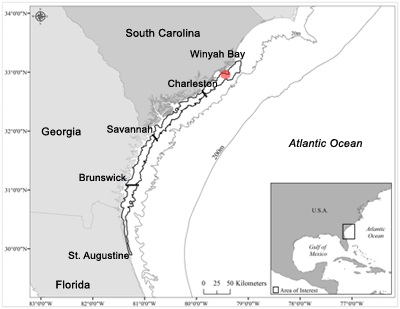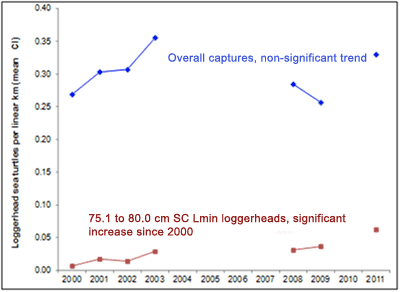Sea turtle catch rates
Research surveys, other coastal waters
Fishery-independent trawling to capture sea turtles was first conducted by the MRD off an important South Carolina nesting beach between May, July, and August 1979 [14]. Seventy trawling events were conducted aboard the RV Atlantic Sun using paired 40’ headrope flat nets, all but seven of which were conducted between 7am and 7pm. Trawling was conducted to the north and south of Cape Romain shoals, offshore of Cape Island between Raccoon Key and Sandy Point. Only three sea turtles (two loggerheads and one Kemp’s ridley) were captured.
Subsequent to a stated need by the Turtle Expert Working Group (1998) to collect, "long-term, in water indices of loggerhead abundance in coastal waters…to identify relative abundance of sea turtles over time, and to detect changes in size composition with implications regarding recruitment", a panel of experts crafted a study design for conducting a regional trawl survey in coastal waters of the Southeast U.S. Management of this survey was awarded to the MRD, which initiated the survey in partnership with the University of Georgia Marine Extension Service in summer 2000. Trawling was conducted at randomly selected locations between Winyah Bay, SC (33.1°N) and St. Augustine, FL (29.9°N).

The regional sea turtle trawl survey area (adapted from Arendt et al., In press) off the coasts of SC, GA, and northern FL. The red dot near the entrance to Winyah Bay, SC denotes the trawl area surveyed by Ulrich (1979).
Despite initial concerns about potentially poor catch rates in a regional trawl survey based on the efforts to target loggerhead sea turtles near a critical nesting beach in 1979, 172 loggerhead sea turtles were captured in 621 trawling events during the first year of this historic study. Through 2011 this survey was completed in its entirety during seven summers, and is slated to continue through at least through 2013. Consistent with observer and shipping channel studies, catch rates are appreciably greater today than several decades ago. Significant increases in capture rates between 2000 and 2011 have been noted for loggerhead sea turtles [15] measuring 75.1 to 80.0 cm (the size associated with maturity) and overall capture rates for Kemp's ridley sea turtles (unpublished data).

A comparison of overall loggerhead sea turtle catch rates (blue line) and catch rates for loggerhead sea turtles with shells that measure 75.1 to 80.0 cm (29.5 to 31.5 in) minimum straight-line carapace length. Although overall catch rates have remained essentially stable since 2000, catch rates for large juveniles approaching maturity increased significantly during the same period.
Sea turtles are also incidentally captured in two other surveys operated by the MRD. Juvenile green sea turtles are occasionally captured during trammel net surveys in estuarine waters. Loggerhead and Kemp’s ridley sea turtles have also been commonly captured by the Southeast Area Monitoring and Assessment Program (SEAMAP-SA) which has conducted trawling at coastal index stations between Cape Hatteras, NC, and Cape Canaveral, FL during spring, summer, and fall since 1989.
14 Ulrich, G.F. 1979. Marine turtle trawl surveys off South Carolina nesting beaches, 1979. Completion report to the National Marine Fisheries Service for Award NA79-GA-A-00128,14p.
15 Arendt MD, Schwenter JA, Segars AL, Byrd JI, Whitaker JD, and L. Parker. 2012. Temporal trends (2000–2011) and influences on fishery-independent catch rates for loggerhead sea turtles (Caretta caretta) at an important coastal foraging region of the Southeast U.S. Fishery Bulletin 110(4):470–483.
